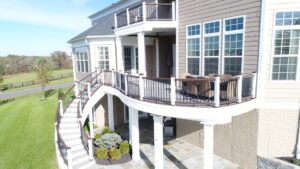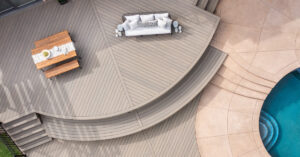How to Bend Composite Decking
By Dave KileComposite decking has completely changed the game for outdoor living, offering a winning combination of durability, looks, and low maintenance. As someone who’s worked with composite decking for years, I’ve seen curved decks and inlays surge in popularity. There’s something about those graceful curves that speaks to us, blending with nature’s own contours and enhancing the visual appeal of our outdoor living spaces.
 To bend composite decking, you need to apply heat and gentle pressure. The key is heating the boards to make them pliable, then carefully shaping and holding them in place while they cool. With the right techniques and a bit of practice, you, too, can bend composite decking like a pro.
To bend composite decking, you need to apply heat and gentle pressure. The key is heating the boards to make them pliable, then carefully shaping and holding them in place while they cool. With the right techniques and a bit of practice, you, too, can bend composite decking like a pro.
I’ve distilled what I’ve learned about the board-bending process into this practical guide. From suitable materials and precise measurements to heating techniques and support systems, let’s dive into the essentials of bending composite decking and kickstart your own curved composite deck project!
Step-by-Step Guide on Bending Composite Decking

Step 1: Select the Right Decking Material
Choosing the right composite decking material is essential for achieving successful bends. Color and texture are important, but not all composite decking is designed or suitable for bending. Some composite decking products may be too rigid or lack the necessary flexibility to be bent into curves without risk of damage or structural integrity issues.
I opt for high-quality boards from brands like Trex, TimberTech, or Azek, which are engineered for flexibility and can withstand the rigors of bending without sacrificing performance. Check the manufacturer’s specifications and recommendations for your specific composite decking product to determine if bending is advisable before making a purchase.
Step 2: Ensure Precise Measurements
Accurate measurements are the foundation of a successful curved deck project. Visualize the desired curves, considering how factors such as traffic flow, seating arrangements, and architectural or structural features play into your deck design.
Create a deck plan and plot your curves. While a tape measure and string can work, I find a flexible curve ruler or bending template streamlines this process. Having a clear plan will be instrumental in creating your cooling supports, which you’ll need in Step 4.
Step 3: Heat the Composite Board
Heat makes composite boards pliable and easy to bend. I’ve used various heat sources, including heating blankets, heat guns, and even direct sunlight on a warm day with the right conditions. (Related, if the sun makes your deck surface too hot for comfort, cool off your deck with some of my best tips.)
Experiment to find the optimal temperature range for your specific decking, typically 200-300°F (93-149°C). Always start at a lower temperature and slowly work up to a higher temperature to avoid blistering.
If you’re using a heating pad under your board, I recommend a length of insulation underneath. You can also sandwich the board, topping it with a second pad and insulation layer. If you opt for a heat gun, lay your board on a heat-resistant surface like a concrete floor, metal sheet, or a specialized mat.
Heat your board evenly and gradually until it becomes bendable. Keep an eye on the temperature using a thermometer or, if you’re like me, just carefully monitor for pliability while heating. If you’re working with multiple composite decking colors, be aware that the temperature and heating time may differ.
Step 4: Support Your Curves During Cooling
Once your decking board is pliable, it’s time to make the bend. Before reaching this point, though, be sure your cooling supports are ready to go: They’ll guide your curves and securely hold your boards until they cool.
Common support methods include wooden or metal braces, clamps, and molds or forms. Personally, I choose a racetrack-style form made from equidistant PVC boards screwed to plywood—a method also favored by Dr. Decks.
Use your plan from Step 2 to determine the shape of your form or the spacing of your supports. Remember that if you have multiple boards to bend, each unique radius requires a separate form or support system.
With your supports in place, apply gentle pressure and guide the heated board along your planned curve. Avoid overbending or forcing the decking; this can cause cracks or structural weakness.
Use the supports to hold your boards in place until they’ve fully hardened, which may take up to several hours. Resist the temptation to remove boards prematurely, which could result in the loss of curvature. Once the boards have cooled completely, you can remove the supports and install them on your deck.
Now that you’ve created these graceful curves be sure to protect your deck substructure with flashing before installing them for a long-lived oasis—and maintain your decking’s wow factor with regular surface cleaning.
Potential Risks Associated with the Bending Process
 Bending composite decking opens up beautiful design possibilities for your deck, but take care to avoid these pitfalls:
Bending composite decking opens up beautiful design possibilities for your deck, but take care to avoid these pitfalls:
- Warping and Cracking: Rapid temperature changes or excessive force can damage composite decking boards. Heat the boards gradually and evenly to avoid warping and cracking and avoid applying excessive pressure during bending.
- Delamination: Delamination occurs when the layers of composite decking separate. To prevent delamination, use high-quality composite decking material, follow manufacturer guidelines for bending, and use proper supports during cooling.
- Overheating: Excessive heat can damage composite decking, leading to discoloration and melting. To avoid overheating, closely monitor the temperature during the heating process and apply heat sources carefully. Start at a lower temperature and gradually increase as needed.
- Misshapen Curves: Insufficient support during bending and cooling can result in misshapen or distorted curves. Verify supports are correctly positioned following your plan and hold the boards in place securely.
Bending composite decking may seem daunting at first, but with careful planning and attention to detail, you can achieve stunning results. Enjoy the process and the beautiful outdoor living space you’ll create!
